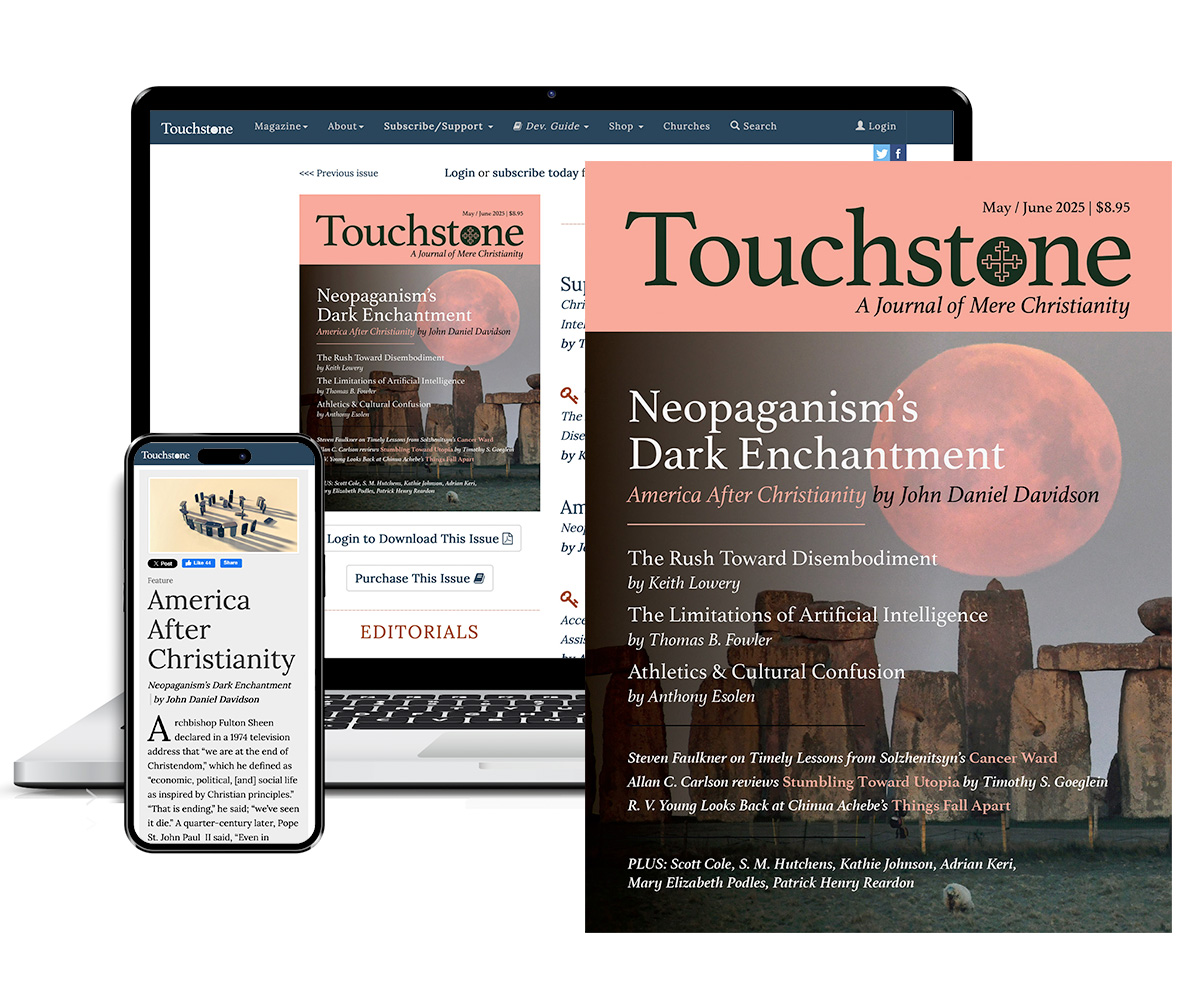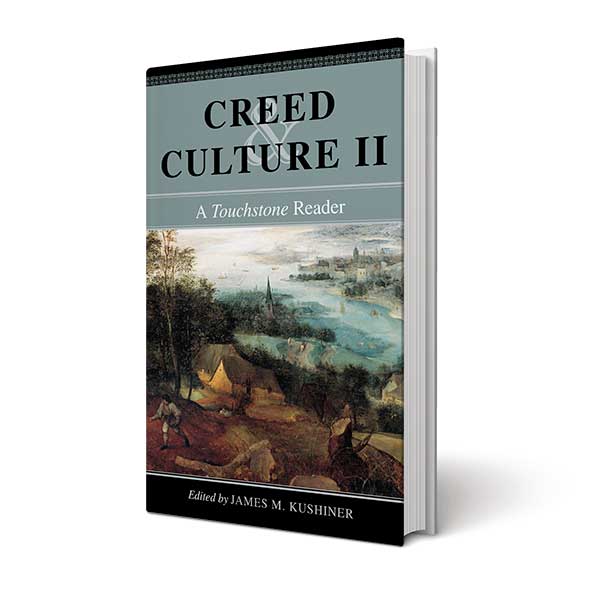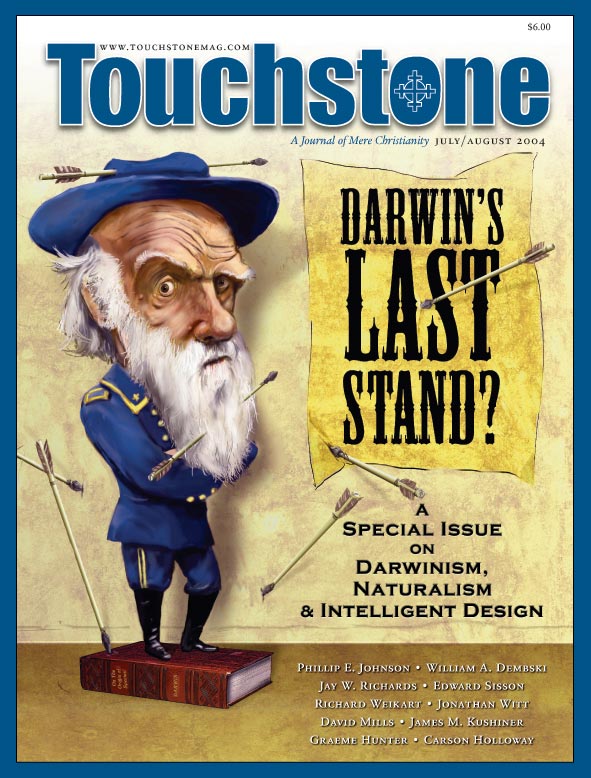Reality & Reluctant Science
Old Science Confronts a Formidable Challenge in the Scientific ID Movement
by Jay W. Richards
At the end of the nineteenth century, mainstream science held a simple view of the universe. The official—and materialistic—view went something like this: (1) The universe has always existed, and so we need not address the question of its origin; (2) everything in the universe, large and small, submits to a few well-understood, deterministic laws; (3) life initially turned up as a result of luck and chemistry; (4) cells, for their part, are basically little sacs of gel; and (5) nearly all those complicated adaptations of organisms result from a starkly simple process called natural selection: this almost miraculously creative process merely seizes and passes along those minor, random variations that help a creature survive.
Religion might have had its place, but science was the one source of objective, certain, nonsectarian knowledge. It was the one source of knowledge for “the public square.” Religion, and even ideas that might have theological implications, were to be safely quarantined in the private realm of subjective opinion.
The indispensable intellectual support for this picture of the world was provided by the positivist interpretation of science, and of knowledge generally. Positivism was a program designed to purge “metaphysics” from science, to force scientists to posit only impersonal explanations for the facts it observes. As the National Academy of Science has put it in our day, “the most basic characteristic of science [is] reliance upon naturalistic explanations.”1 As a result, it forbade scientists to appeal to intelligent agency when trying to explain either the features of the natural world or the natural world itself.
Such a stricture obviously eliminated a divine agent, but it eventually became clear that it eliminated agents in general. Everything was thought to be reducible to the impersonal interactions of physical laws and matter, and nothing else mattered. In fact, many senior physicists had concluded that physics was basically a complete science, and there was little left to do except tidy up the theory here and there.
Reality Rebelled
But almost as soon as this Procrustean bed was made, the real world refused to lie in it. In the early twentieth century, the startling revelations of the quantum realm suggested that the world was not quite as submissive as the materialists had expected. In the 1920s astronomer Edwin Hubble discovered that the light from distant galaxies was “red-shifted,” indicating that the universe is expanding. This and other details suggested that the universe had come into existence in the finite past—that it has an age. This flatly contradicted the earlier picture of an eternal and self-existing cosmos and raised again the question of its origin.
Then, in the 1960s and 1970s, physicists began to notice that the universal constants of physics, such as the forces of gravity and electromagnetism, seemed to be “finely tuned” for the existence of complex life. To astrophysicist and atheist Fred Hoyle, this suggested the activity of a “superintellect.”
Darwinism itself had been coming in for a sustained critique, and not just from “creationists.” Michael Denton’s Evolution: A Theory in Crisis and other books by mainstream writers showed that the Darwinists’ evidence did not sustain the Darwinists’ confident claims, a point made more recently in Jonathan Wells’s Icons of Evolution.
Still more recently, growing evidence in astronomy has revealed that even in a finely tuned universe, many local things have to go right to build a single habitable planet. Moreover, the requirements for habitability also seem to provide the best overall conditions for making scientific discoveries. You might expect this if the universe were designed for discovery, but not if you were a card-carrying materialist.
But even an environment suitable for life does not produce life automatically. There remains, for example, the nagging problem of the origin of biological information, which stubbornly transcends its chemical medium in the same way the letters and sentences of a book transcend the chemistry of ink and paper.
We see this starkly in molecular biology, where the presence of information encoded along the DNA molecule looks suspiciously like an extraordinarily sophisticated computer code for producing proteins, the three-dimensional building blocks of all life. Move up a level and we find complex and functionally integrated machines that look quite inaccessible to the Darwinian mechanism. Michael Behe’s Darwin’s Black Box showed that the structure of some of these molecular machines, of which Darwin knew nothing, could not easily be explained in Darwinian terms but could be explained in terms of design.
We see it also in the three-dimensional complexity of animal body plans, which profoundly outstrips our understanding of the informational systems present at the lower levels. Finally, there are human agents themselves, which are so unexpected that some materialists actually try to deny their existence. Some cognitive scientists refer dismissively to belief in such agents as “folk psychology.”2
Add to this evidence the philosophical problems with positivism itself. Perhaps the most severe one was this: Many positivists claimed that only statements that can be verified by the senses are meaningful or scientific. That statement, however, cannot itself be verified by the senses. This means that, by its own accounting, it is meaningless, or at least “unscientific.” At the same time, any criterion of science liberal enough to avoid this contradiction and accommodate actual scientific practice let metaphysics in as well.
Such problems, scientific and philosophical, eventually led to the demise of the entire positivist enterprise. The positivists themselves openly admitted this. In a BBC radio interview, Brian McGee asked the father of logical positivism in England, the Cambridge philosopher A. J. Ayer, what was the main defect of positivism. Ayer replied that the main problem was that it was “nearly all false.”3
A Different World
At the beginning of the twenty-first century, we look out at an utterly different world from that envisioned by the materialistic science of the late nineteenth century. It is a world charged with design, a cosmos that points beyond itself to a transcendent and intelligent cause.
But the word of this is not out! On the contrary, the dominance in scientific and educational circles of the materialist definition of science inherited from the nineteenth century still prevents us from considering this new evidence openly. The problem is so acute that some scientists are willing to posit an infinite panoply of unobservable universes to explain away the fine-tuning in our universe.
This difference between what the evidence of nature shows us and what the official science community says and teaches led a professor of law, Phillip E. Johnson, in the 1990s to ask a singularly pregnant and subversive question: If the materialistic definition of science and the scientific evidence are in conflict, should we go with the definition or the evidence? To ask the question, as they say, is to answer it. Scientia means knowledge. The essence of natural science is the search for knowledge of the natural world. Knowledge is an intrinsic good. If we are properly scientific, then, we will seek to be open to the natural world, not decide beforehand what it is allowed to reveal.
The materialistic definition of science is no mere philosophical trifle. It dictates what may be discussed, funded, and published, at least within official circles. It dictates what is taught in schools, and thus what worldview young people imbibe in courses that pretend not to be teaching a worldview at all, but only objective, “value-neutral” science. This cultural and institutional power makes materialistic science look like an unyielding structure, extending invincibly into the clouds like Jack’s Beanstalk.
But if the evidence is as I have described it, then that monolith must surely have its weak spots. So it must, and so it does: just where materialistic science does not fit the natural world it is supposed to explore and explain. These are its fissures, the cracks in its arguments. Research that focuses on just those cracks—those pressure points—might work like a wedge, which, when driven in deeply, splits a structure wide open, and liberate science and culture from the intellectual prison of the materialist worldview.
Such was the vision that led in 1996 to the founding of a program called the Center for Science & Culture, at the Discovery Institute, a think tank in Seattle. Since then, the program and the wider intelligent design (ID) “movement,” which includes several key organizations and scores of individuals, have come a very long way.
ID Accomplishments
Perhaps the principal way the Discovery Institute contributes to the ID community is to support research and writing at pressure points in a variety of natural sciences: those places in nature where the evidence for design is strongest and the case for materialism is weakest. Why must such research be supported by a private organization? Because of the unfortunate hangover from nineteenth-century materialism, much of the scientific establishment rejects out of hand proposals that seek to consider the viability of intelligent design.
The key areas in developing a scientific case for intelligent design include all the evidence mentioned briefly above. Some of the best-known “pressure points” are information-rich molecules like DNA, and tiny molecular machines like the bacterial flagellum, which biochemist Michael Behe immortalized in his best-selling 1996 book, Darwin’s Black Box.
Behe argued that the flagellum and many other molecular machines are “irreducibly complex.” They are like a mousetrap. They do not work without all of their fundamental parts. Natural selection can only build systems one small step at a time, by traversing a path in which each step helps the organism survive a present danger to its survival. It cannot select changes that will only be useful in the future, when combined with others in a complex system. Such foresight is the exclusive domain of intelligent agents. William Dembski, in his book No Free Lunch, has extended and strengthened Behe’s argument.
Others have developed complementary arguments. Stephen Meyer, in a number of important articles in books such as Science and Evidence for Design in the Universe, has carefully developed both an empirical and a logical argument against purely materialistic origin-of-life scenarios.
In a lengthy article in the recent book Darwinism, Design, and Public Education, Meyer, Marcus Ross, Paul Nelson, and Paul Chien focus on another piece of evidence. They argue that design is apparent in the history of life, on the basis of the profusion of animal life that appears in the fossil record as the so-called Cambrian Explosion. And very recently, in The Privileged Planet, astronomer Guillermo Gonzalez and I have developed an argument for design and purpose based on evidence from physics, cosmology, and astronomy. These are just a few examples of the growing case for intelligent design.
But not all of the important work is in natural science per se. Some of the work is conceptual. Materialism, after all, is a philosophy, even if its contemporary purveyors confuse it with science, the better to sell it to a public who would resist honest materialism. Thus, the ID community features a number of able philosophers dismantling the bankrupt philosophy of materialism.
Moreover, intelligent design needs a strong philosophical framework. For most of Western history, detecting the activities of intelligent agents has been a mostly intuitive enterprise. Books such as The Design Inference by philosopher William Dembski have dramatically strengthened the case for design by bringing it into the publicly accessible realm of objective argument and empirical evidence, and out of the murkier realm of intuition.
A Withering Influence
And then there are the laborers in the social sciences and humanities. The materialistic worldview has always had profound cultural consequences, most of them bad. Just think of the effects of Darwin, Marx, and Freud on the modern mind.
The cultural prestige of materialism rests largely on the perception that it is grounded in science. But what if it is built on sand, as the withering influence of Marx and Freud already suggests? What if reductionism in physics and biology are equally at odds with the evidence, and it just hasn’t been officially announced yet? What if the natural world, looked at fairly, exhibits evidence of purpose and design? What would that mean to the social sciences, to the high and popular arts?
Finally, because of our concern for both science and culture, many ID theorists, and the Discovery Institute specifically, have focused not only on academic research, but also on the reception of that research in education and public policy. Among the self-appointed “skeptics” who see the public sphere as their exclusive jurisdiction, this has led to widespread metaphysical panic.
Before 1996, there had been little published work advocating intelligent design in natural science. Denton’s Evolution: A Theory in Crisis and The Mystery of Life’s Origins by Walter Bradley, Charles Thaxton, and Roger Olsen were both published in the mid-1980s and laid important groundwork, but it was Johnson’s Darwin on Trial in 1991 that first reached a wide audience and catalyzed an intellectual movement.
Since 1996, the ID community has been extraordinarily successful in publishing books. In fact, we have exceeded our most optimistic early projections. Fellows of the Center for Science & Culture, for example, have published some forty books, some with popular trade and Christian presses, others with prestigious academic presses like the Oxford, Cambridge, and Michigan State university presses.
Similarly, ID theorists have published numerous scientific, academic and popular articles, including a cover story in Scientific American and a group of essays debating intelligent design in a special issue of Natural History, which for many years published a regular column by the evolutionist Stephen Jay Gould. Conferences and debates about intelligent design have been held at major secular universities like Yale and Harvard, and at the American Museum of Natural History. Most of these events were the first of their kind. Without doubt, the debate over intelligent design has reached a high level of scientific, academic, and popular discourse.
A Media Presence
Although we still have a long way to go, the media coverage of intelligent design has clearly improved. In 1996, Phillip Johnson was the only nationally known figure in the ID movement, and national coverage was limited to only two or three op-eds written by ID proponents themselves.
In 1999, when the movement started attracting regular third-party media coverage, most of it was negative. Since then, we have started to receive fair and even favorable media coverage in the national print media, including The New York Times, The Wall Street Journal, The Los Angeles Times, The London Times, and the major newsmagazines. ID theorists have published many articles in The New York Times, The Wall Street Journal, The Washington Post, The American Spectator, The Weekly Standard, and National Review, and have appeared on most of the major networks.
Although intelligent design received some favorable coverage in Christian media as early as 1996, that coverage has become frequent and widespread in more recent years. Intelligent design is often featured in the pages of Christianity Today, World, Books & Culture, the National Catholic Register, First Things, and, of course, Touchstone, which dedicated a special issue to the subject in 1999, republished by Brazos Press as Signs of Intelligence. And probably not a day goes by without some ID proponent being interviewed on a talk-radio show somewhere in the United States.
All this coverage helps increase the public awareness of intelligent design. But the public reception of science is mediated largely by science documentaries. Television documentaries have been profoundly important outlets for good and bad science for decades. It was Carl Sagan’s popular Cosmos series on PBS in the 1980s that brought scientific materialism to millions, with its vaguely doxological opening line: “The Cosmos is all that is, or ever was, or ever will be.”4 In building public knowledge of design theory, such documentaries are essential.
Happily, after much blood, sweat, and tears, two documentaries on intelligent design were released in 2002. The production quality of both equals or exceeds the typical science documentary on PBS or Discovery Channel. Icons of Evolution, produced by Coldwater Media, deals with the case against Darwinism and focuses on science education. The program has been widely disseminated, and has aired on network affiliates in Ohio and Texas. Unlocking the Mystery of Life, produced by Illustra Media, makes the case for the intelligent design of life.
In April 2003, NETA, the largest independent buyer for PBS, offered Unlocking to the PBS affiliate market. Unlocking has since been broadcast in almost every major PBS market, often during prime time. It is available on the PBS website in their biology section, and has even been featured as a “top selection” for science and math on the PBS website, alongside documentaries by Stephen Hawking and Carl Sagan.
Breakthroughs & Setbacks
Finally, there have been seminal breakthroughs in science education policy. Prior to 1996, Darwinian orthodoxy was virtually unchallenged in public school science education. In the 1980s, a series of ill-conceived attempts to require creationism in public schools established bad legal precedent, and made it difficult for teachers to question any aspect of Darwinian theory in the public schools.
But in 2001, the United States Congress approved the “Santorum amendment,” which called for public schools to “teach the controversy” about subjects such as biological evolution, as part of the No Child Left Behind Act.5 Senator Rick Santorum (R-Penn.) first introduced the language as a mostly symbolic “sense of the Senate” resolution, and it passed 91–8. That could easily have been the end of it. But nearly identical language survived the committee that reconciled the Senate and House versions of the bill, and it was included in the conference report of the act itself, which was signed into law. As part of the conference report, the Santorum language gives guidance to state legislators and judges in interpreting the act.
In response to this federal legislation, in 2002–2003, the Ohio State Board of Education approved a provision requiring students to learn scientific criticisms of Darwinian evolution. Then, in February 2004, the Ohio board went on to develop and adopt the first science curriculum structured specifically along the lines of this “teach the controversy” approach. The brave decision of the Ohio board is a profound victory for academic freedom, and represents a loosening of the stranglehold of Darwinian fundamentalists over public science education.
Similarly, after a months-long debate over science textbook adoption in Texas, several major textbook companies fixed errors relating to the so-called “icons of evolution” (well-known textbook evidences for Darwinism that are misleading or false, like the famous diagrams by Ernst Haeckel comparing vertebrate embryos). These actions have national implications, since Texas is the second largest market in the country. The changes made by publishers for the Texas market are likely to be preserved in many other states as well. These policy and educational victories have established precedents for the debates in other states that lie ahead.
We now find ourselves in a paradoxical situation, in which each victory creates new opportunities, and therefore, new challenges. In the wake of the decisions in Ohio, for example, many other states are examining their science standards. The federal No Child Left Behind education act requires all fifty states to do this by 2007.
But the act does not include penalties for states that fail to live up to its “teach the controversy” standard. This means that every state will debate the issue separately. Unless bright individuals take up the cause in their own states, the status quo is almost certain to prevail. In science education, the status quo is Darwinian dogma, immune from all critical scrutiny. In fact, critics portray any such scrutiny as religious, and therefore as an impermissible violation of the separation of church and state, an attempt by “fundamentalists” to “impose their values,” and the like.
This takes place as the opposition to intelligent design has stiffened. Barry Lynn, of Americans United for Separation of Church and State, has publicly threatened lawsuits against school districts that even allow intelligent design to be discussed. “The Supreme Court has rejected the idea of balanced treatment between science and pseudoscience,” he said. “And it would cost school boards a tremendous amount of money to fight this.” Such threats have attended even attempts to criticize highly debatable aspects of Darwinian theory.
At least eight books have been written in an attempt to discredit intelligent design, most focusing on its alleged philosophical illegality and the supposed religious motives of its leading proponents. In December 2003 alone, three such books were published. Those who oppose intelligent design retain immense power—in scientific organizations, university departments, the media, and the legal system. Virtually every official science organization has felt compelled to issue some denunciation of intelligent design, and especially of its bearing on science education.
It is hard to overestimate the hostility toward intelligent design in most secular, and many religious, university departments. Not surprisingly, there is now a distinguished roster of scientists and other academics who have suffered intense hostility and even job threats as a result of their association with design theory. Still, it doesn’t do anyone any good to dwell on such indignities and injustices. With such important issues at stake, this is the cost of the fight. The materialists may have the power, but we have the evidence and the arguments.
Still to Come
The ID community has come a long way in a few short years. But what does the future hold? I expect the book of nature to assert itself whether or not intelligent design ultimately succeeds as an intellectual movement. Still, ID theorists have much left to do if they are to contribute to a long-term shift in the science and worldview of our culture in our generation.
While a growing number of books are exploring the implications of intelligent design outside the natural sciences, there are still crucial pieces of the scientific case left to complete. While ID theorists have made a persuasive case that design is both detectable and present in the natural world, we are still focusing on only a few areas. Much of the action so far has been limited to biology, but most of the universe is non-biological.
And even within biology, we hear a lot about bacterial flagella, for instance, but not a lot about non-genetic or “epi-genetic” factors in hereditary and biological development, or the so-called “convergence” of structures in organisms that are not closely related. Rigorously quantified research on, say, protein structure, and disentangling the effects of design from processes like natural selection, are still in the future. And there is still much to be done in sciences like cognitive psychology.
Much of this work will appear in book form, as did many of the foundational texts of modern science, such as Darwin’s On the Origin of Species. But at least some of the research must appear in scientific journals. No one involved has any illusions about how difficult this is. Scientific journals tend to perpetuate the reigning paradigm.
Many design theorists already publish in the mainstream, peer-reviewed science literature. What is difficult is to publish in this literature while critiquing materialism and arguing explicitly for intelligent design. This is well-nigh impossible, for obvious sociological reasons. Consider, for instance, the recent complaint by Lynn Margulis, herself a vocal critic of intelligent design:
More and more, like the monasteries of the Middle Ages, today’s universities and professional societies guard their knowledge. Collusively, the university biology curriculum, the textbook publishers, the National Science Foundation review committees, the Graduate Record Examiners, and the various microbiological, evolutionary, and zoological societies map out domains of the known and knowable; they distinguish required from forbidden knowledge, subtly punishing the trespassers with rejection and oblivion; they . . . determine who is permitted to know and just what it is that he or she may know.6
Margulis’s complaint provides a good stiff dose of reality. We have no more won the war than had the Allies after the invasion of Normandy. Enormous resources and intellectual labor must still be marshaled to turn the beachhead we’ve achieved into victory. And much of that labor is not mere publicity, as vital as that aspect of the work is. ID theorists must do creative and rigorous research in natural science.
In fact, its future success should be judged, at least in part, on whether it encourages and elucidates such research. The cultural consequences will surely follow.
Notes:
1. Quoted in Phillip E. Johnson’s Darwin on Trial (InterVarsity Press, 1993), p. 7.
2. I’m really not making this up. Consider, for instance, a conversation between arch-Darwinists Stephen Pinker and Richard Dawkins, in which Dawkins asks Pinker a telling question: “Am I right to think that the feeling that I have that I’m a single entity, who makes decisions, and loves and hates and has political views and things, that this is a kind of illusion that has come about because Darwinian selection found it expedient to create that illusion of unitariness rather than let us be a kind of society of mind?”—from “Is Science Killing the Soul?” by Richard Dawkins and Steven Pinker, published in the online magazine Edge 52 (April 8, 1999), www.edge.org/documents/archive/edge53.html.
3. Men of Ideas, edited by B. McGee (BBC, 1978), p. 131.
4. Ballantine Books, 1993, p. 4.
5. For more details see: www.discovery.org/csc/resources/resourcesSantorumStatement.php.
6. Lynn Margulis, “Big Trouble in Biology,” Slanted Truths, edited by Lynn Margulis and Dorian Sagan (Springer-Verlag, 1997), p. 265.
Intelligence on the WebFollowing (in alphabetical order) are six of the major organizations working on intelligent design (ID) and the related issues. All include links to other ID websites and news of developments in ID theory, and most include bookstores. Access Research Network (ARN) ARN offers a free e-mailed newsletter called ARN Announce. The site includes a list of featured authors (including Charles Darwin), with links to their articles. ARN publishes a quarterly journal, Origins and Design, edited by Nancy Pearcey. It includes feature articles, news and commentary, lengthy book reviews, and a helpful survey of the literature (ID and evolutionist). The writers include many of the well-known names as well as substantial and as yet lesser-known scholars. Many of the articles are available on the website. The group also sponsors a student organization (www.idurc.org). This site includes interviews with ID leaders like Jay Richards, Paul Nelson, and Michael Behe; material to help students think through the questions; discussion forums; and the chance for students to post their own papers. The Center for Science and Culture of the Discovery Institute The center offers a free e-mailed “e-lert” called Nota Bene. It offers an extensive archive of articles by its fellows (including most of the major figures in the ID movement) and others. Design Inference Website Intelligent Design and Evolution Awareness Center (IDEA) International Society for Complexity, Information, and Design
(ISCID) ISCID offers a free e-mailed newsletter; online reading and discussion groups; a forum called “Brainstorms”; a journal called Progress in Complexity, Information, and Design, whose content is posted on the site; and news of intellectual developments in the field; as well as summer workshops and essay contests for students. Origins In addition to the usual features, Origins offers transcripts and video of the debates between the Evangelical apologist William Lane Craig and Corey Washington, Michael Tooley, and Peter Atkins; and similar resources. Two other sites readers will want to consult are Francis Beckwith’s website and Phillip E. Johnson’s “The Leading Edge” . Dr. Beckwith, a professor at Baylor University, writes extensively on legal matters related to ID. Dr. Johnson, the patriarch of the ID movement, writes a regular column for Touchstone. |
Jay W. Richards is vice president and senior fellow of the Discovery Institute in Seattle. He is the author most recently of The Untamed God (InterVarsity, 2003) and co-author with astronomer Guillermo Gonzalez of The Privileged Planet: How Our Place in the Cosmos Is Designed for Discovery (Regnery, 2004).
subscription options
Order
Print/Online Subscription

Get six issues (one year) of Touchstone PLUS full online access including pdf downloads for only $39.95. That's only $3.34 per month!
Order
Online Only
Subscription

Get a one-year full-access subscription to the Touchstone online archives for only $19.95. That's only $1.66 per month!
bulk subscriptions
Order Touchstone subscriptions in bulk and save $10 per sub! Each subscription includes 6 issues of Touchstone plus full online access to touchstonemag.com—including archives, videos, and pdf downloads of recent issues for only $29.95 each! Great for churches or study groups.
Transactions will be processed on a secure server.
more on science from the online archives
more from the online archives
calling all readers
Please Donate
"There are magazines worth reading but few worth saving . . . Touchstone is just such a magazine."
—Alice von Hildebrand
"Here we do not concede one square millimeter of territory to falsehood, folly, contemporary sentimentality, or fashion. We speak the truth, and let God be our judge. . . . Touchstone is the one committedly Christian conservative journal."
—Anthony Esolen, Touchstone senior editor












